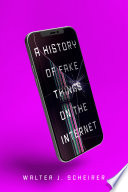

The book outlines how fake content has evolved from simple hoaxes to complex misinformation campaigns. Initially, fake content was limited to pranks and urban legends shared among friends or in small communities. With the advent of the internet, particularly social media, the scale and sophistication of fake content have dramatically increased. The author discusses pivotal moments in history, such as the rise of forums and later social media platforms, that facilitated the rapid spread of misinformation. This evolution reflects a broader trend in digital communication, where the lines between fact and fiction become increasingly blurred.
Continue readingTechnology plays a crucial role in the propagation of fake content. The book delves into algorithms used by social media platforms that prioritize engagement over truthfulness, often amplifying sensational or misleading content. The author explains how these algorithms create echo chambers, where users are only exposed to information that reinforces their beliefs, further entrenching misinformation. This technological aspect highlights the responsibility that tech companies have in moderating content and curbing the spread of false information.
Continue readingThe book examines the psychological underpinnings that contribute to the belief in fake news. Cognitive biases, such as confirmation bias and the Dunning-Kruger effect, are explored in detail. The author argues that people are more likely to accept information that aligns with their pre-existing beliefs and that a lack of knowledge in a certain area can lead individuals to confidently endorse false information. Understanding these psychological factors is essential for developing strategies to combat misinformation.
Continue readingFake content has far-reaching implications for society, affecting everything from politics to public health. The book discusses case studies, such as the spread of misinformation during elections and the anti-vaccine movement, demonstrating how fake news can influence public opinion and behavior. The author emphasizes that the consequences of misinformation can lead to real-world harm, including loss of trust in institutions and detrimental health outcomes, underscoring the urgent need for media literacy.
Continue readingThe book provides a historical context for understanding fake content, tracing its roots back to ancient times. The author highlights examples from history, such as propaganda during wars and the use of fake news in political campaigns. By examining these historical precedents, readers can better grasp the ongoing battle against misinformation and the recurring patterns that emerge in different contexts. This perspective allows for a deeper understanding of current challenges in the digital age.
Continue readingIn response to the challenges posed by fake content, the book outlines various strategies that individuals and organizations can employ to combat misinformation. These include promoting media literacy, developing critical thinking skills, and encouraging responsible sharing practices. The author also discusses the role of fact-checking organizations and the importance of transparency in information dissemination. By equipping readers with practical tools, the book aims to empower individuals to navigate the complex landscape of information.
Continue readingThe concluding chapters of the book speculate on the future of fake content in an increasingly digital world. The author discusses emerging technologies, such as deepfakes and AI-generated content, that pose new challenges for authenticity. The potential for these technologies to create hyper-realistic fake content raises questions about trust and verification in the digital age. The author calls for a collective effort from individuals, tech companies, and policymakers to address these challenges proactively.
Continue reading